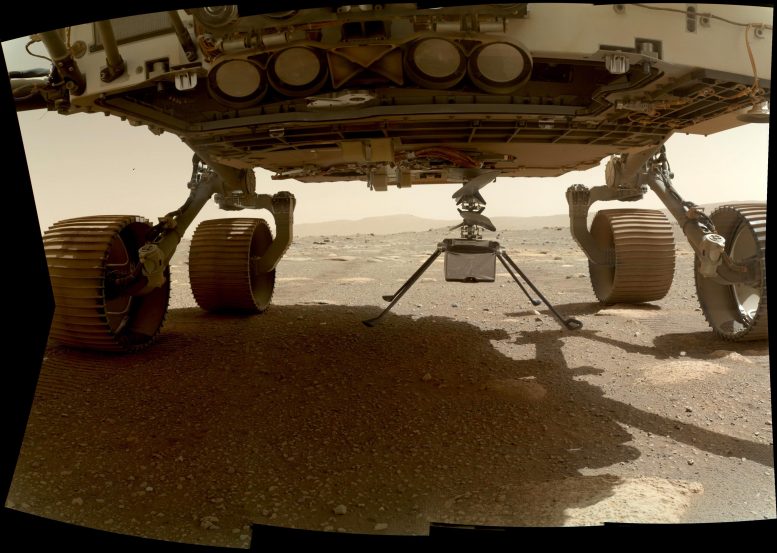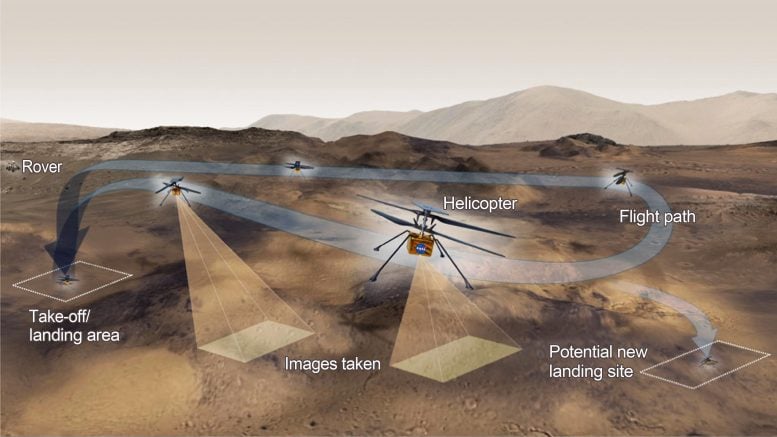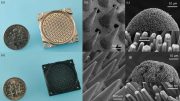
NASA’s Ingenuity helicopter can be seen here with all four of its legs deployed before dropping from the belly of the Perseverance rover on March 30, 2021, the 39th Martian day, or sol, of the mission. This image was taken by the WATSON (Wide Angle Topographic Sensor for Operations and eNgineering) camera on the SHERLOC (Scanning Habitable Environments with Raman and Luminescence for Organics and Chemicals) instrument, located at the end of the rover’s long robotic arm. Credit: NASA/JPL-Caltech/MSSS
Beginning April 2021, the window opens for the first flight of NASA’s Ingenuity Mars Helicopter. (Currently, the first flight is expected no earlier than April 11.) It will be history’s first attempt at powered, controlled flight on another planet. Ingenuity arrived at Mars on February 18, 2021, riding along with NASA’s Perseverance rover.
Before it attempts takeoff, the Mars Helicopter must first survive the arduous journey to Mars – from the turbulent liftoff to the harrowing landing – as well as dangerously cold nights where it must maintain power to keep itself warm enough to operate. The duration of Ingenuity’s mission is 30 days, where one or more test flights will be attempted.
As a technology demonstration, Ingenuity is testing a new capability for the first time: showing controlled flight is possible in the very thin Martian atmosphere. If successful, Ingenuity could lead to an aerial dimension to space exploration, aiding both robots and humans in the future.

This graphic shows the general activities the team behind NASA’s Ingenuity Mars Helicopter hopes to accomplish on a given test flight on the Red Planet. The helicopter will have 31 Earth days (30 sols, or Martian days) for its test flight program. Credit: NASA/JPL-Caltech
NASA’s Jet Propulsion Laboratory built and manages operations of Perseverance and Ingenuity for the agency. Caltech in Pasadena, California, manages JPL for NASA. WATSON was built by Malin Space Science Systems (MSSS) in San Diego and is operated jointly by MSSS and JPL.
The Mars helicopter technology demonstration activity is supported by NASA’s Science Mission Directorate, the NASA Aeronautics Research Mission Directorate, and the NASA Space Technology Mission Directorate.
A key objective for Perseverance’s mission on Mars is astrobiology, including the search for signs of ancient microbial life. The rover will characterize the planet’s geology and past climate, pave the way for human exploration of the Red Planet, and be the first mission to collect and cache Martian rock and regolith (broken rock and dust).
Subsequent NASA missions, in cooperation with ESA (European Space Agency), would send spacecraft to Mars to collect these sealed samples from the surface and return them to Earth for in-depth analysis.
The Mars 2020 Perseverance mission is part of NASA’s Moon to Mars exploration approach, which includes Artemis missions to the Moon that will help prepare for human exploration of the Red Planet.









Be the first to comment on "NASA’s Ingenuity Mars Helicopter Prepares for Takeoff"